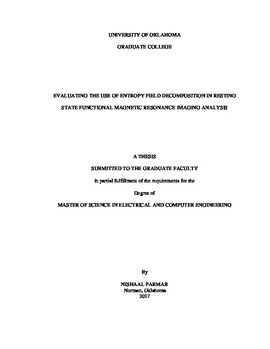| dc.description.abstract | The study of resting state functional magnetic resonance imaging (rs-fMRI) data has been the subject of increasing academic interest over the past decade. Despite a growing understanding of the base activity networks (modes) of the human brain, current tools used in rs-fMRI analysis show limited adaptability toward the complexities inherent within intricate and densely connected neural networks. Direct regression analysis is foiled by the multiple, low-SNR, intricate functional networks which characterize the resting state, while advanced analysis methods such as independent component analysis (ICA) are designed to be used on sparse, independent activity signals rather than connected, distributed and overlapping resting state modes.
Entropy Field Decomposition (EFD) is a new analysis technique based on the measurement of neural functional connectivity, rather than neural activity. As an integration of entropy spectrum pathways into information field theory, EFD represents a powerful mathematical method for analyzing the eigenmode connectivity of the brain via local coupling & clustering analysis. EFD may distinguish between non-Gaussian, non-linear, non-periodic, spatially and temporally overlapping signals using the measured space-time correlations present in the data itself.
This thesis explores the method behind the EFD algorithm, then examines a study performed on the effects of the drug ibuprofen on resting state brain function, and uses EFD analysis of subject data to verify the basic viability of the EFD algorithm in fMRI analysis. Although no direct correlation was found between ibuprofen dosage and observed resting state brain response, EFD analysis showed greater functional connectivity in the right hemisphere than in the left hemisphere in nearly all cases. | en_US |
